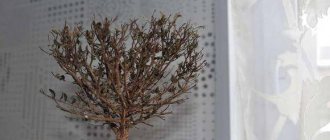Plants » Flowers
0
2100
Article rating
Kira Stoletova
When growing ficus plants at home, gardeners often encounter problems related to caring for home flowers. It is not uncommon for ficus leaves to fall off.
Causes of ficus leaves falling
The time is coming
For many ficus lovers, the period when the latter suddenly begins to shed its leaves comes as a complete surprise. They begin to look for the reasons that lead to the fact that the leaves turn red, darken to the color of rust, their tips turn inward, bend and deteriorate.
Thus, for the Benjamin (Impalce) flower and its curly variety Nitida, the slightest changes in the state of indoor comfort become the reason for the loss of leaves: a change in care methods, replanting, an attempt to propagate in winter or autumn.
Ficus, even with proper care, loses leaves every year; this is a natural process of changing leaves in winter. Falling occurs at the onset of the autumn-winter season. This is due to the aging of vegetation and the need for its renewal. Immediately with the arrival of cold weather, the leaves droop, become lethargic, turn yellow, curl and fall off. In winter, the leaves on the ficus fall off or do not dry out entirely, but only the lower ones, at the beginning of the trunk. With the onset of spring warmth, new and young ones will grow on the empty ficus trunk.
Description and photo of Ficus Benjamin
The plant is a typical representative of the flora of South Asia, growing in its natural environment up to 15-20 meters or more. An ornamental tree at home can grow up to 3 meters , but many prefer to stop growth at 50–100 cm. It lends itself well to crown-forming pruning, which has made it a favorite among those interested in the art of bonsai.
Characteristics of culture:
- the trunk of the tree is straight, even;
- small, glossy leaves with entire edges;
- the bark is light, gray, with dark patches;
- the crown is very wide, the branches are drooping;
- growth is intense.
Breeders have developed many varieties of Ficus Benjamin, which differ in size, leaf color, and shape. But they all retain the ability to add charm to green areas, decorate any room, creating a summer atmosphere in all seasons.
Causes of leaf fall
If the ficus has dropped its leaves or they have drooped, withered, bent, curled up, turned yellow and brown, or fly off not only when the cold season sets in, the reasons lie in improper care: the home flower is missing something.
One of the most common reasons for leaf fall is a change in the climatic conditions in which the plant is accustomed to developing, which most often occurs during its propagation or transplantation.
Often, changing the location of a flower pot is a temporary phenomenon, so that a flower with curled leaf blades hangs down the foliage and then throws it off. In such a situation, it is quite possible to restore the former beautiful crown of the flower and root it before the leaves of the ficus fall off completely.
Among other reasons why ficus sheds its leaves, the most well-known in home floriculture are:
- excessive importance;
- sudden temperature changes and drafts,
- moving to new conditions immediately after transplantation,
- insufficient lighting,
- oversaturation of the soil layer with moisture,
- the presence of insectivorous parasites and fungal infections,
- soil contaminated with pesticides.
Rules of care
When planning to get such a flower, you should decide in advance where it will stand even when it grows into a large tree - after all, changing its place of residence is extremely undesirable. The atmosphere around the ficus should be at a comfortable temperature and moderately humid; the flower loves to be sprayed.
How to water the “capricious”
Watering should be moderate, there is no need for excessive soil moisture - ficuses prefer the air in the room where they live to be humid (about 75%), and waterlogging of the soil can become a negative parameter. Water for irrigation should be at room temperature. You need to water regularly so that the earthen ball does not dry out, but only after the top layer of soil has dried out. Approximately 1/5 of the soil in the pot should become dry. It is better to saturate the soil with water in several stages.
When watering the ficus for the first time, the next day after watering you need to check whether water has accumulated in the pan - then you should water the plant less. Small ficuses in small pots are watered once every 2-3 days, and grown plants - once a week, or even every 10 days.
If the room is cool, watering is done less often. If the soil is waterlogged, it is better to let it dry for one and a half to two weeks. The affected plant should recover during this time, but if there is no positive dynamics, the flower will have to be replanted, changing the soil and removing rotten roots. The surviving root system must be washed with a weak solution of manganese.
Instructions for use and dosage of Roundup herbicide
The importance of fertilizing
Special organic fertilizers are considered a special “delicacy” for ficuses. They can be of different types for different stages of plant growth. So, when it is in the phase of active growth and leaf formation, a large percentage of nitrogen should be present in the fertilizing. In winter, on the contrary, nitrogen-containing additives are undesirable, because the plant is dormant and new shoots do not develop due to insufficient lighting.
The transplanted tree does not need feeding, because the fresh earthen mixture contains enough nutrients that will last for about two months. If there is a deficiency of iron, ficus is fed with iron chelate and ferrovite. Before fertilizing the plant, it must first be watered and fertilized the next day.
Transplanting a plant
At first, the young flower is replanted annually, when it reaches the age of four years, the replantation is carried out as the root system grows. For this, choose the spring season or early summer. First, water the ficus generously, then carefully remove its roots from the pot along with the earthen ball.
The top layer of soil is removed, and a new pot is taken with a diameter 3 cm larger than the previous one. Drainage and a little earthen mixture are poured onto the bottom, ficus roots are installed, fresh soil is poured in, compacting along the edges. If the tree is already very large, then replanting it may be difficult; then all you need to do is replace the top layer of soil with a fresh one.
Reproduction by cuttings
During the period of active growth of the ficus - in spring and summer - layering can be done from it. The tops of the shoots, which have a couple of leaves, are cut off and placed in water or dropped into wet sand. If the branches are standing in water, then you must remember to change it periodically. Once the roots appear, you can plant the young ficus in a pot; cover the top with film or a jar. When the first new leaf appears on the plant, you can remove the cover.
Do I need to dig up lily bulbs for the winter?
How to form a crown
Despite the beauty of the ficus, it still needs to be pruned. Due to pruning, axillary buds develop, and young branches grow from them, making the plant more lush. The most important pruning is perhaps for ficus benjamina. He perfectly knows how to take a given shape and becomes more magnificent. Before pruning, the pruning shears must be treated with manganese or alcohol to disinfect. The central trunk is cut to no more than 20 cm, leaving at least five leaves on it.
If the crown is thick enough, then the side branches can be shortened at your discretion and even removed. Be sure to sprinkle the cuts with crushed charcoal. To form a trunk, five upper branches are left, and the side ones are completely removed. For a plant standing on the floor, the crown is formed at a height of about a meter, and for a tabletop plant, the height for forming a stem is 40 cm.
Since the trunk of a young ficus is very flexible, it is better to use a support. Sometimes, to make the composition look more beautiful, several plants are planted in one pot. As they grow, their flexible trunks intertwine and twist together, forming bizarre shapes.
Diseases
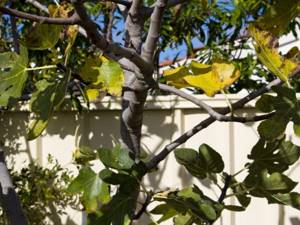
Improper care can cause illness
In the list of common reasons why ficus trees shed leaves, the first number is emerging infections and care problems. In most cases they are easily removable. Measures taken in time make it possible to revive an indoor flower.
Avitaminosis
Lack of nutritional components in the soil where the ficus grows leads to shredding of the leaves. With inadequate feeding and improper care, when the indoor climate is too dry and the temperature is too high, the situation gets worse: the ficus leaves become smaller, you can see how they droop and dry out, which often leads to falling off. If there is insufficient fertilizer, the ficus usually begins to fall off from the bottom up.
Rot
When yellow spots appear on the leaves of a ficus, we can talk about rot on the root system of the plant, which has appeared due to excessive watering. An excess of liquid, which does not have time to evaporate from the soil layer in the pot, leads to rotting, yellowing, falling leaves and death.
Hypervitaminosis
Oversaturation of the soil with fertilizers also adversely affects the quality of ficus foliage. For these reasons, brown spots appear on the leaves - specks; over time, the foliage turns black and flies off. Fall occurs randomly.
Pests
The presence of spider mites, aphids, scale insects and other insect pests on the plant looks like convex spots of a brown or brownish hue, the leaf blades turn white from plaque.
Parasites can settle along the veins of the leaf blade. You can save a flower from excessive shedding of leaves by using modern pest control products. As a result, a plant will grow with a beautiful green crown.
Fungal infections
Signs of rot and sooty fungus are black or red spots of mold, which are located on the outer part of the leaf blade and may be present on the stem of the plant. Ficus leaves affected by a fungal infection begin to turn yellow and fall off. A fungal disease that is not detected in a timely manner becomes a frequent cause of plant death, and in a short time.
Diseases and pests
Diseases and pests of ficus are diverse, but almost all of them affect weakened plants that are forced to grow in unfavorable conditions or do not receive quality care. Leaf fall can be caused by:
- Gray rot.
- Sooty fungus.
- Powdery mildew.
- Cercospora blight.
- Anthracnose.
- Root rot.

Most of these problems are easily identifiable. The leaves don’t just turn yellow or dry out, but take on an unhealthy, repulsive appearance: gray or black coating, brown spots or dots.
Ficus pests: thrips, scale insects, nematodes, scale insects, aphids, spider mites.

You may be interested in:
How to identify negative factors and diseases of an orchid An orchid is resistant to diseases and pests. However, some ailments still damage...Read more...
Fact!
The most common pest in typical apartments is spider mites. He loves dry, hot air. What to do if it is obvious from the photo that it is a spider mite? The fight against it is quite simple: a thorough shower + further maintenance of a sufficient level of air humidity.
Initial measures

The flower can be saved
When asked what to do if the ficus leaves fall, most gardeners advise finding out exactly the cause of this process and eliminating it by establishing proper care.
If parasites are detected and signs of a fungal infection are present, immediate measures to save the flower are taken:
- At the initial stage of development of ficus disease, the affected areas of the plant are cut off, and the remaining intact foliage is cleaned of pests and mold stains using a soft brush, rinsing with running water.
- Disinfection is carried out by treating the stem and leaves with garlic infusion, made from 60-80 g of garlic, infused in a liter of boiling water for an hour. The procedure is carried out daily until the foliage problem is completely eliminated.
- Soap-alcohol mixtures can be used as disinfection, to create which laundry soap is mixed with a spoonful of alcohol in equal proportions, the ficus is sprayed with this solution at intervals of 4 days and then the leaves are washed after 12 hours. The full course of treatment is 2 weeks.
- Treatment of an indoor flower from dropping leaves can be carried out using specialized products designed to combat parasites and fungal infections of plants.
Preventative care at home
Properly selected methods for growing Ficus Benjamin are the key to success in growing these ornamental plants. Despite their unpretentiousness, they may react poorly to transplants, temperature changes or uneven watering.
Care measures:
- It is imperative to check the soil: if it is dry at a depth of 3–5 cm, watering is required.
- Do not move the pot unnecessarily from place to place.
- Young plants are replanted once a year, adults - once every 3-5 years, renewing the soil.
- Once a month you need to inspect the foliage, checking for pests, and remove damaged blades.
- It would be a good idea to give the tree a soap bath once every 6 months, thoroughly washing the crown and trunk.
Prevention is much easier than treatment. We should not forget about this. If the crown-forming pruning is carried out correctly, old branches and foliage are removed, and the soil is loosened, emergency treatment may never be required. And the magnificent greenery will delight the gardener for decades.
There are at least a thousand different types of ficus in the world, but the ficus benjamina is most often used as a houseplant. Thanks to its excellent decorative qualities and unpretentiousness, this flower has a huge number of hybrids that differ in size, color, crown shape and many other features.
But there are problems to which all Benjamins are almost equally susceptible. In particular, we are talking about such an unpleasant phenomenon as dropping leaves. There may be several reasons for such a disaster, but, as a rule, all of them can be characterized by one phrase - improper care.
Causes of foliage loss in some species
Different types of ficus may have different reasons for leaf loss. This determines exactly how to care for the plant.
Ficus benjamina
The reason for yellowing and falling leaves of Ficus Benjamin can be:
- A change in the usual conditions of detention, since this species does not tolerate changes in conditions, temperature fluctuations, or decreased light conditions. Moving the Benjamin ficus from its usual warm place to a colder one will cause it to shed its leaves.
- Sudden changes in temperature and hypothermia as a result of contact with cold window glass or placing a flower container on a cold ceramic surface, therefore the place for the pot is chosen so that the leaves do not freeze.
- Unfavorable conditions: excess light conditions, excessively dry air, overdried soil, leading to the appearance of yellow spots and yellow edges on the leaves.
- Imbalance in feeding: lack of micro- and macroelements, as well as oversaturation of the soil with fertilizers.
The natural process of ficus Benjamina changing foliage occurs not only in the autumn. The foliage of this species can fall during the winter, losing the crown by 10-20%. If an indoor flower begins to lose leaves every day, it is worth analyzing its watering and sufficient lighting.
Rubber-bearing species
This ficus is the most resistant and can withstand almost any conditions of maintenance and care, however, it may also have reasons to shed its leaves, including:
- waterlogging of soil and stagnation of water,
- insufficient lighting in the room,
- excessive fertilization of the land with fertilizers,
- reduced temperatures and the presence of drafts.
Another reason why a rubber ficus may shed its leaves is an unsuitable flower pot for it. If a slightly constricting pot would be more suitable for an indoor Benjamin flower, the Rubber-bearing species prefers freedom, therefore the container for its cultivation should be larger in size and not constrict the plant, otherwise its leaves begin to become smaller in size and fall off after a while.
What types of ficus are there?
Ficus trees are represented by a huge number of species. Some of them grow in the wild, usually in tropical and subtropical zones, where these plants grow truly gigantic. Most often, home ficuses come in the following types:
- ficus benjamina is a small-leaved plant with mottled green and white leaves;
- rubbery. The leaves of this flower are large, smooth, green;
- Bengal. The leaves are medium long, dense and velvety, dark green in color;
- dwarf (or Pumila) - ampelous species, with flexible stems and small heart-shaped leaves;
- lyre-shaped. Large bright green leaves with wavy edges.
Subtleties of preserving the ficus crown
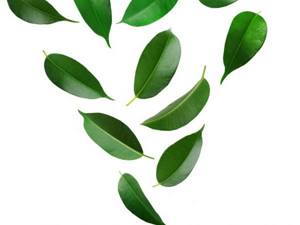
Different varieties have their own care characteristics
During the cultivation of various types of ficus, many gardeners noted that this plant reacts unfavorably to certain factors.
sunlight
Not all species like direct sunlight on the leaves. If variegated types of flowers are light-loving, some ficuses, for example, Benjamin, prefer shading for comfortable well-being.
In winter, it is recommended to place the flower pot closer to the window, because the lack of lighting in the place where the ficus grows will certainly affect the quality of its leaves - they will begin to fall off.
Water
Ampelous large-leaved varieties of ficus love frequent spraying. To preserve their foliage, sufficient moisture is most important, therefore, during the growing process, many gardeners place the flower pot directly on pallets with pebbles or expanded clay and constantly keep them moist.
Unlike hanging species, tree-like ficuses like their soil layer to be dry and free of lumps.
Transfer
Frequent replanting adversely affects the quality of foliage of all types of ficus. Often for this reason, indoor flowers begin to shed their leaves, which is why experienced gardeners are of the opinion that the plant should be replanted no more than once every two years.
For large plants that have already grown, only the top layer of soil needs to be replaced.
Why does ficus shed its leaves?
All reasons can be divided into two classes:
- Natural.
- Associated with violations of agricultural technology.
The visual difference between them is not difficult to notice: in the first case, the remaining leaves will be vigorous and green, and the fallen ones will be few in number. In the second, the process will be noticeably more intense, and the general appearance of the plant will cause concern.
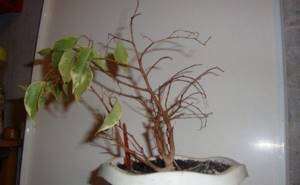
Natural causes
The loss of several lower leaves of a young ficus should not be embarrassing. This is a natural exposure of the trunk. All types of ficus are either trees or shrubs. The trunk becomes woody with age, and the leaf mass is concentrated on the younger branches in the upper part. Ficus benjamina can reach a height of 2-3 meters indoors, and 25 meters in nature. Depending on the type of formation, the bare trunk can be from 10 to 50 cm.
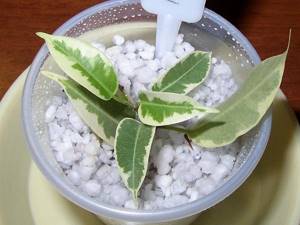
Fact! Adult ficus trees over 5 years old independently organize periods of “molting”. This period usually begins in October and lasts 1-1.5 months. This is due to the need for renewal: old foliage is not as effective as young foliage.

You may be interested in:
How and when to water potatoes Potatoes are crops that are sensitive to insufficient watering. To get a bountiful harvest of healthy...Read more...
Lack of fertilizers
Feeding a houseplant is an important element in caring for it, because the amount of soil and, accordingly, the nutrients in it available for the root system is very limited.
Without receiving the necessary components for normal development, the ficus begins to get sick and shed its leaves.
Fertilizers should be applied during the period of intensive growth (spring and summer), using universal organic and mineral mixtures. It is best to purchase special fertilizers for ficus plants or, if none are found, combined additives for non-flowering indoor plants.
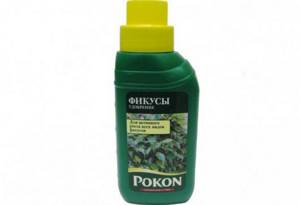
The usual frequency of fertilizing is twice a month, but depending on how long ago the plant was replanted (the degree of soil depletion), this frequency can be adjusted. Fertilizer should not be applied immediately after transplantation, as this can cause burns to the roots.
In the wild, tropical plants have virtually no resting phase; their growing season lasts all year round. Once in the temperate climate zone as indoor flowers, ficus plants began to adapt to new conditions, which is why it is better not to disturb them in winter.
But if the temperature regime is chosen correctly and the tree is provided with round-the-clock illumination, it does not need rest, which means it can be fed in winter, using half the usual dose of fertilizers and halving the frequency of their application.
Also during this period, you should slightly reduce the nitrogen content in the fertilizing, because this element is needed for intensive growth and a gain of green mass, which still does not happen in winter.


